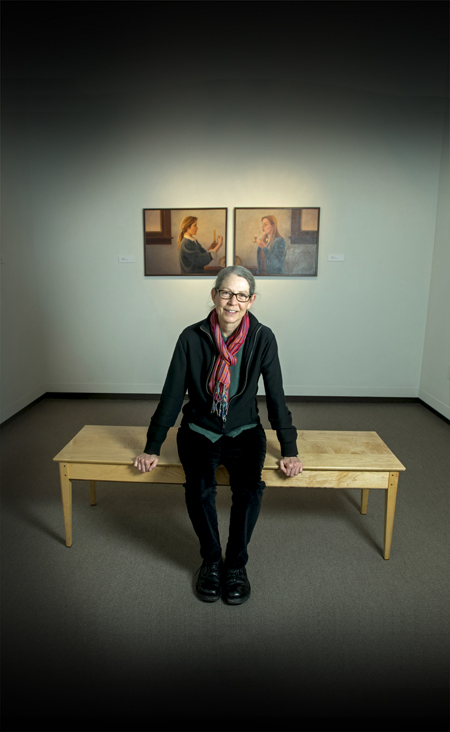- Editorial Offices
- 203 Brantly Hall
- Missoula, MT 59812
- (406) 243-2488
- themontanan@umontana.edu
Facetime: Stephanie J. Frostad M.F.A. '94
Painter Stephanie Frostad makes her living as an artist in Missoula
Stephanie J. Frostad carefully crafts paintings from her imagination, in a way that makes people from across the country feel drawn to the familiar, memory-inducing characters and landscapes she portrays. As she populates her art with recognizable rustic scenes and animals in an anachronistic setting, each painting tells a different story. Frostad, who hails from the Pacific Northwest, felt right at home in the University of Montana and Missoula community when she arrived on campus as a student. Now, 25 years after graduating with her Master of Fine Arts degree, she still makes her living as an artist in Missoula. The Montanan asked her about her process and the meaning behind some of her pieces.
When did you first start painting?
I started painting in Italy in 1985. I did a lot of drawing and printmaking and a fair amount of figurative sculpture before painting seduced me. I couldn’t resist. It is just an intriguing medium. Creating paintings is symphonic, because with drawing, you’ve got different visual textures and tones, but not all the power and drama and potential mayhem of color. A lot of the figures you paint are females. What is the significance? In figurative narrative painting, women are mostly there to be looked at, whereas men have more agency. They’re the actors, they’re the protagonists. I’m not trying to correct that, but to show women with a sensitivity to their environment with powers of cognition and with the ability to get where they’re going and do what needs to be done.
 What do the animals represent?
What do the animals represent?
I like to subordinate the human drama to the presence of another creature or something that’s happening in the natural world. If you know the parable of the Prodigal and Dutiful Sons, what happens is when the Prodigal Son returns home, the Dutiful Son is ordered to slaughter the fatted calf. There is a painting of cows, but it’s also the prelude before a slaughter – these things are happening simultaneously in this bucolic painting. The animals aren’t there just to make a pastoral scene. They’re there because they indicate something in an unfolding story.
How has the University of Montana helped you in your journey as an artist?
In really countless ways. The people I worked most closely with had really distinct modes of working and perspectives. Once you’re a graduate student, it’s more about presenting the right challenges and degrees of encouragement to help someone develop their own vision. It’s supported independence. Those are things that are important to me and I want to celebrate. I’m really grateful to them.
How do you make a living as an artist?
I live pretty simply, but it allows me another kind of creative freedom. I don’t know how you quantify or put a price on that. How we make our living as artists is changing. I never had any training or professional practices, because, all those years ago, basically what an artist did was create strong work and find galleries to represent them. Now, one must be so much more a promoter of one’s own work with social media. Even if you have gallery representation, there’s still the expectation that you’re on Instagram, and there’s a constant renewing feed of images. I have a lot more to do outside the studio to sustain myself.
How important is narrative artwork to our society?
I think human beings are storytelling animals, and I believe that narrative cohesion is essential to individual well-being. If a child has a continuous story, even if there’s hardship in that story, they’re a healthier, more resilient person. I think it’s true for our society too where we have narrative cohesion. We can be healthier and more resilient. I think that all the arts that tell stories – whether they are dance or painting or obviously literature – can help us form and live in that more cohesive narrative.
Could you describe the process from starting a painting to its completion?
Often I have a theme that I’m working on, and I start to just research its fundamentals. My most recent body of work centered on two ravens I borrowed from Nordic mythology, Hugin and Munin, who are companions of the chief god, Odin. They would go out each day and gather news of the world and bring it to Odin. They were like his spies, constantly doing reconnaissance. “Munin” has traditionally been translated as “memory” and “Hugin” as “thoughts.” And I started populating my work with them.I start to gather references because all the work is composite. In the “Return of the Prodigal Son,” those cows that are in the foreground are based on a photo I took at the Western Montana Fair of a brown Swiss cow and her calf laying in the barn. All the figures in the background – the Prodigal Son, his father, his mother – I modeled for those. I set up my camera on a tripod and took photos with the self-timer of myself in each of those poses. The Dutiful Son, who’s holding the middle ground between the cows and the family – he’s based on a boy I drew out of a book. The tree is complete invention, the hillside is – all of that is just invented. The composition is made from pulling together all of these disparate elements. It’s like working a puzzle into this whole.
What would be your advice to students studying art at UM?
If you’re an artist, if you love art, make sure you make it, and you’ll love your life. I see people with great gifts and abilities suffer from not practicing their craft. Whatever challenges there are to making art or time for art, there’s a lot to be said for ensuring that it remains a part of what you are in the world and how you respond to life and changing circumstances. Part of the reason I am an artist is I love to learn. Everything I take up enriches my understanding of the world. So, never stop learning.




